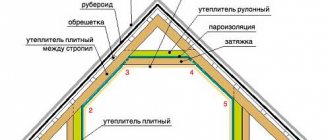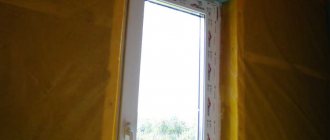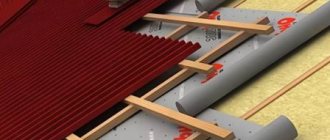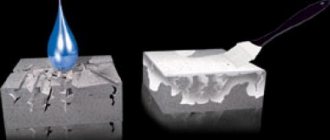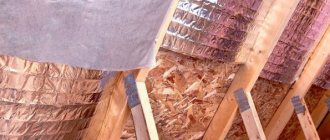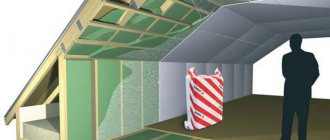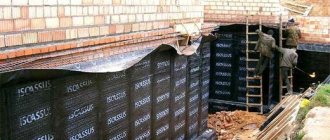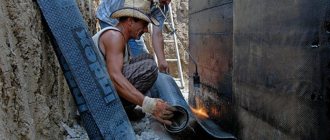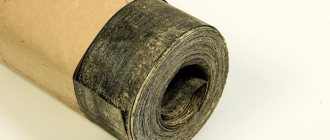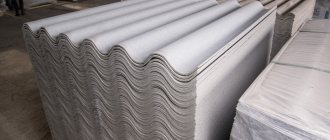External differences between vapor barrier and waterproofing
What is the external difference between waterproofing and vapor barrier? This question can be answered by analyzing the structure of both materials.
Structure of vapor barrier films
Installation of vapor barrier is carried out from the inside of the roof
Before purchasing any film, be sure to make sure that it is a vapor barrier, as indicated by the inscription on the packaging.
Structure and types of waterproofing films
It may well seem to an amateur that if the vapor barrier is completely waterproof, then it may well serve as a replacement for the waterproofing layer. One can assume, even out of ignorance, that vapor barrier is better than waterproofing, which is fundamentally wrong.
Both vapor barrier and waterproofing film materials serve strictly to achieve a specific purpose, and if you replace one with the other, this can lead to unpredictable consequences and additional monetary costs.
The main functions of waterproofing are as follows:
- protection from external moisture entering the insulation layer;
- removing accidentally trapped water vapor from the insulation.
Waterproofing polymer films have a number of useful properties:
- resistance to ultraviolet radiation;
- resistance to temperature fluctuations;
- high strength characteristics.
Based on the type of porous structure, membrane films can be:
- diffusion;
- superdiffusive.
Superdiffusion membranes significantly exceed diffusion films in terms of vapor removal, and there is no need to create a ventilation gap between the waterproofing and the insulation.
The organization of a ventilation gap between the roofing covering and the membrane is mandatory in any case in order to allow water vapor to escape with the air flow into the atmosphere.
Waterproofing is laid over the roof insulation
The main differences between insulating layers
The difference between vapor barrier and waterproofing lies in their intended purpose. Both of these layers protect the insulation, but the waterproofing layer does this from the outside, and the vapor barrier layer prevents the penetration of steam and moisture from the inside.
A vapor barrier is different in that it does not allow anything to pass through, while a waterproofing film has microscopic holes on the surface that allow warm air to leak from inside. This is the external difference between the films.
Installation of layers
The installation of films is also different; waterproofing is carried out according to the following rules:
- The film is laid out in two ways: parallel or perpendicular to the roofing frame, consisting of slats.
- It is mounted with an overlap of at least 10 centimeters.
- Special counter rails are used for fastening.
- Do not overstretch the waterproofing film.
- The fastening of the canvases can be done using tape.
Laying the vapor barrier layer begins only after the installation of thermal insulation is completed. This should be done according to the following rules:
- Any direction of installation.
- Fastening is done using slats, the distance between which should be no more than 50 cm.
- The overlap of the canvases is 10 cm.
- You can use a construction stapler to secure the film.
If you follow all the rules for installing vapor barrier and waterproofing layers, the insulation will be reliably protected. This will allow you to significantly save on heating, and will also protect the house from dampness and mold, and from destruction.
If you accidentally mix up the materials used to create layers of vapor and waterproofing, this will lead to destruction of the insulation. As a result, it will be inevitable to dismantle the entire roofing pie with a complete replacement of all three layers.
Types of vapor barrier materials
Films made of polyethylene and polypropylene
Vapor barrier: polyethylene film
It is not practical to use ordinary polyethylene films for vapor barrier of steam rooms: they quickly lose their properties at high temperatures, but they can be used in washing rooms or changing rooms/dressing rooms.
Vapor barrier: polypropylene film
Membranes
As a rule, a two-layer polypropylene vapor barrier is mounted on the inside of the insulation with the smooth side close to the insulation. For example, if a vapor barrier is installed in the attic of a bathhouse, then the rough side should be at the bottom.
Double-sided membranes can be laid on either side - they operate in both directions.
Vapor barrier: diffuse membranes
Foil materials
Foil vapor barrier on the ceiling and walls of the steam room
There are several types of such materials:
Cheap vapor barrier for baths
Liquid (coating) vapor barrier
Vapor barrier: liquid rubber
Bath lovers and experts recommend using only foil roll materials for vapor barrier of the ceiling and walls of the steam room, which not only serve as a vapor barrier, but also reflect thermal radiation inside, reducing the cost of maintaining the temperature.
How not to confuse insulating materials ↑
Vapor barrier films ↑
Such films have an absolutely waterproof surface on both sides, i.e. they do not let in any moisture and do not let out any. The cheapest version of such film is ordinary polyethylene, used in vegetable gardens. True, it can only be used for roofing as a last resort, because it is always hot under the roof, and the thin film is destroyed and stretched by the temperature. The best option is a multilayer film with a reinforcing frame made of polymers. The frame prevents it from stretching and sagging, and many layers ensure a long service life.
A more expensive, but very useful type of vapor barrier film is foil, i.e. on one side having a layer of foil. This film is placed with the foil side inside the roof to reflect infrared radiation, which causes the bulk of the heat to escape from the premises. By using such a film to insulate steam, you will automatically increase the level of heat retention, which means you will pay less for heating.
Waterproofing films ↑
The films described above are not suitable for waterproofing, because they are absolutely waterproof. They, of course, will not let moisture in from the outside, but this is not enough for the normal functioning of the roofing pie. The fact is that the waterproofing layer performs one more task: it removes accidentally trapped vapors from the insulation. The question may arise: where do they come from, if there is a film barrier inside and outside too. It turns out that there is no film in the world that is 100% waterproof. Some of the steam will still leak out of the premises or the ventilation layer, so you need to make sure that the moisture finds its way out. For this purpose, special waterproofing films called membranes were invented. They are made of polymers and are characterized by increased strength, resistance to temperature changes and ultraviolet radiation. But their most important property lies in their structure: it is porous. This is done so that steam can seep through the pores under the roof.
There are diffusion and superdiffusion membrane films. Both have pores that resemble microscopic funnels. The operating principle is based on the fact that a water molecule has a larger volume than a steam molecule. So steam escapes through the wide part of the funnel, but moisture from the outside cannot penetrate through the narrow “neck”. When using membranes, it is important to place them with the correct side: the wide part of the pores is towards the insulation, the narrow part is towards the roofing.
The structure of both films differs in the number of pores. Thus, diffusion membranes require that their pores not come into contact with the insulation, otherwise the funnels will become clogged with mineral wool and will not function. In such roofing pies, the waterproofing layer must be surrounded on both sides by ventilation gaps: one between the insulation and the membrane, the second between the membrane and the roofing material. The superdiffusion membrane has a much higher level of vapor removal, so there is no need for a ventilation gap between the insulation and the membrane.
Membrane films are not suitable for all types of roofing, but only for those that are not afraid of condensation on the back side. So, for example, metal tiles require a special waterproofing film, which is called anti-condensation film. It does not release steam from the insulation outside, but accumulates it on its back surface with the help of many tiny fibers. And from there the moisture evaporates with the help of air flows from the ventilation gap.
Only the proper use of vapor barrier and waterproofing films will ensure a dry ceiling and warm air in the rooms.
How to attach a vapor barrier
The choice of fastening method depends on the type of vapor barrier material used. Polyethylene and polypropylene films are secured with small nails or with staples and a construction stapler.
Construction stapler (mechanical)
Attaching the vapor barrier
The sheets of rolled materials are laid one on top of the other with an overlap of at least 10-15 cm, gluing the joints with adhesive tape. You can use specialized, foil or regular adhesive tape.
Double-sided adhesive tape UNIBOB based on cotton fabric. An adhesive layer based on synthetic rubber, which ensures high quality gluing of vapor-waterproofing sheets
Vapor barrier manufacturers
There is a large selection of vapor barriers on the market today from different manufacturers. A decent share of the market is occupied by Izospan materials (Gexa company). Today the following types of products are produced:
By the way! It will be interesting to know:
Materials for vapor barrier: Izospan B
There are a number of other companies with good reviews:
- trademark Delta company Dorken (Germany)
- Yutafol, Yutavek produced by Juta (Czech Republic)
- Klober (Germany)
- Tyvek films DuPont (USA)
- Fakro (Poland)
What is a vapor barrier?
Before considering the differences between vapor barrier and waterproofing, it is necessary to clearly define both materials.
Vapor barriers are special materials that provide reliable protection of mineral insulation and building structures from the effects of water vapor.
Application area
Increasing the energy efficiency of buildings and reducing energy costs are directly related to the presence of a thermal insulation layer. Wherever thermal insulation materials are used, a vapor barrier is required. This is especially true for:
Thus, almost all key elements of the building require vapor barrier.
Materials
On the construction market, vapor barrier materials are presented in a wide range. They may differ in cost, performance characteristics and service life. The most common vapor barriers include:
There are other types of vapor barriers that are less widespread. These include liquid rubber and polymer burlap.
The fundamental difference between waterproofing and vapor barrier
Vapor barrier differs from waterproofing mainly in that both sides of the coating are completely waterproof. The vapor barrier film should not allow either steam or water to pass through, both outside (into the house) and inside the enclosing structure. Waterproofing should protect against external moisture and help remove accidentally trapped water vapor. In this case, it is necessary to clearly understand the functional purpose of each protective material and use the desired combination in certain cases. Replacing a waterproofing film with a vapor barrier can lead to disastrous results.
In this matter, it will not be amiss to familiarize yourself with the following video clip:
The search for an answer to the question of how vapor barrier differs from waterproofing is often carried out when choosing the type of protection for a structure. Different materials help solve different problems : they retain moisture and warm steam, thereby maintaining the structure of the thermal insulation “pie”. The market offers a wide range of protective coatings. They are characterized by different properties.
Floor waterproofing - what types exist?
There are three types of floor insulation before installing the screed. They differ in technology and materials:
- Coating – oxidized bitumen, which contains organic and inorganic additives, such as: latex;
- plasticizers;
- rubber crumb.
This material is manufactured in such a composition to increase fluidity when applied to the coating. After complete hardening, the waterproofing covers the surface with an elastic and durable film that does not allow water to pass through.
Liquid glass, bitumen and polymer mastics are coating materials with high adhesion.
Coating waterproofing not only provides good protection for floors and slabs, but also serves as a reinforcing frame for the screed.
- Pasting - using materials in rolls. The waterproofing composition consists of polymers, fiberglass and reinforcement. Recently, manufacturers have begun to produce self-adhesive roll materials.
It is worth noting that in this situation, for better adhesion of the composition to the concrete, a burner is used to heat the insulation.
- Combined, used if there is high humidity in the room, kitchens, bathrooms. Such floor waterproofing for heated floors perfectly protects the floors, and accordingly your neighbors below, from moisture.
It is planned to use materials of the first and second types of insulation, which are produced in several layers.
Insulating materials
There are many varieties of materials. The area of use and properties are different, so before purchasing you need to read the manufacturer's manual.
Roll materials are:
- Hydroisol;
- Rubiroid;
- Isoplast;
- Filizol.
Sold in rolls, the material is very durable and not afraid of mechanical stress.
This material can be used on any type of floor. The advantage of roll insulation is its ease of use and low cost.
Experts do not recommend using roofing felt for waterproofing bathrooms, toilets and kitchens.
There are two ways to attach roll insulation:
- for bitumen or polymer mastic;
- heating the material with an open flame using a burner.
Paint insulation
This name is used because such waterproofing is applied under a warm floor by applying it to the surface with a brush or roller. It has two application methods - hot and cold.
For example, liquid glass is applied coldly and hardens when exposed to air; this is facilitated by special hardeners added to the composition.
All bitumen-based liquid waterproofing requires pre-heating to a fluid state. Bitumen is applied to the surface and, when cooled, creates a waterproof film.
When treating the floor with insulating mixtures, it is worth coating the adjacent walls to a height of 30 cm. This is especially true for wet rooms.
Self-leveling insulators
The material is quite in demand and easy to use, its only drawback is the cost. But thanks to this waterproofing, a monolithic surface is formed on the floor, completely insulated.
Application is quite simple: the mixture is diluted to the desired consistency, poured onto the floor and leveled with a special needle roller.
Having considered the types of waterproofing, you can begin to carry out work.
What is the difference between vapor barrier and waterproofing?
Both waterproofing and vapor barrier during insulation are carried out in order to protect the insulation from moisture.
The difference between waterproofing and vapor barrier is that waterproofing ensures that moisture does not reach the insulation from the outside, and vapor barrier protects the insulation from moisture generated inside the house.
Obviously, these two types of work are not interchangeable and are of equal importance to ensure a long service life of the insulation, which ensures indoor comfort.
Installation of insulating materials is a necessary measure, since otherwise the installation of insulation will not bring positive results, and you will have to provide additional heating to the room. In modern construction, mineral wool is often used as insulation, which has a high thermal insulation ability, but also has a significant drawback - the ability to absorb moisture. That is why, when installing insulation, it is necessary to take care of waterproofing and vapor barrier. For this purpose, film materials are used.
When arranging the roof, it is necessary to take into account the maximum possible temperature differences outside and inside the room, as well as precipitation in any form and winds up to hurricane force. After all, the roof of a house is essentially a boundary separating the air inside and outside. As we know from the laws of physics: the air that has a higher temperature will always rise upward - to the ceiling.
Of course, the roofing materials themselves do a good job of protecting the insulation from the direct penetration of moisture inside, but they are unlikely to save you from the formation of condensation in the under-roof space - they are not so sealed that they do not allow water vapor to pass through. In this case, high-quality waterproofing will come to the rescue, which will not allow water vapor from the environment to pass into the insulation.
It is worth noting the fact that many unfortunate builders neglect waterproofing the under-roof insulation, buy cheap materials, or even completely replace waterproofing films with ordinary polyethylene from the garden or even vapor barriers, without finding any significant difference between them. Like, it’s film and film in Africa. Anyway.
As a result of such “minor” defects, it turns out, for example, that after a new roof was installed a year ago, water suddenly begins to flow from the attic roof and wet streaks appear on the ceiling. The owners are perplexed. They begin to look for damage and leaks in the roofing, but without identifying any defects in it, they come to the age-old questions - who is to blame and what to do?
But why was there not even a sign of condensation on the ceiling before the renovation? It can be assumed that waterproofing was laid underneath the insulation instead of a vapor barrier, as a result - the properties of the porous insulation clogged with water vapor with all the ensuing consequences have already been lost. If no insulating films were used at all, then moisture will “walk” throughout the entire structure, damaging not only the thermal insulation, but also contributing to the destruction of the rafter system and even the interior decoration.
So what is the difference between waterproofing and vapor barrier?
Roof insulation
And in order to choose what you need, you need to understand exactly what the difference is between materials such as vapor barrier and waterproofing. Let's start with waterproofing for the roof. The purpose of this material is not to let water from the street into the space under the roof. Despite the fact that any roofing material is designed to protect the house from direct rainfall, it can still seep inside, which threatens to wet the laid insulation.
The main function of any vapor barrier material is to protect the insulation from vapors coming from the interior of the house. No matter how high-quality ventilation system you equip, steam will still be present in the rooms: people breathe, food is prepared, humidifiers and irons are used. This way warm steam will penetrate into the insulation.
The presence of a frame will not allow the vapor barrier material to stretch, and many layers of film will ensure the longest possible service life. But the best and at the same time the most expensive type of material for roof vapor barrier can be called foil film. The foil part is laid inside the roof, which will reflect infrared radiation. This film will protect the insulation from steam penetration and increase the level of warm air retention, and you will save on heating in the winter.
Roof waterproofing
The main function of waterproofing films is protection from precipitation, which is implemented when roofing. In this case, they are laid on top of thermal insulation. It is advisable to use windproof films. This is a multilayer material with a porous structure on one side and a smooth surface on the other.
Vapor barrier implements other functions. The main problem that the materials of this group help to solve is the creation of an insurmountable barrier to air rising when heated. If a vapor barrier has not been used, after a short period of use the insulation will accumulate moisture, which will increase thermal conductivity and deteriorate its qualities.
However, this type of coating will retain not only warm steam, but also liquids, so it received another name - vapor barrier. This is the difference between these materials: the action of each of them is aimed at retaining moisture, characterized by a different structure (liquid or water).
Externally, waterproofing and vapor barrier are similar. In reality, it is difficult to notice small pores on the surface of the film. Considering that such coatings are small in thickness, it is often not possible to study the structure even upon closer examination. For this reason, vapor and waterproofing at first glance look the same.
Such materials are divided into 2 groups:
- single-layer, with a smooth surface;
- multilayer: on one side there is a porous layer, on the other there is a smooth surface.
The first option does not allow air to pass through. Accordingly, steam will also not be able to pass through such insulation. The film is made of polyethylene and allows you to create a completely sealed coating. To allow warm air to freely leave the space under the roof slope, diffuse membranes are used.
On one side they contain pores that are widened. This structure allows warm air to pass through the insulation to the outside. However, precipitation from the street will no longer be able to penetrate under the roof. This is due to the location of the pores: their narrow part is located on the side opposite to the room. Water molecules will not pass through such “windows”. This means that there is only one direction of moisture movement for diffuse membranes - from inside the object to the outside.
There is also superdiffusion waterproofing. Its structure is the same as that of the coating considered. However, the membrane layer contains more pores. This ensures a higher level of moisture removal efficiency.
If you are interested in the question of how waterproofing differs from vapor barrier, a parallel is drawn between film and membrane coatings. For example, the membranes are mostly vapor-permeable, but moisture is not retained in the structure of the thermal insulation “pie”, but is transported outside thanks to the ventilation gap, which is specially left when roofing.
Waterproofing in the form of a membrane often contains a reinforcing layer of polypropylene. If you use simple polyethylene film, over time it will deform under the influence of high temperatures and tensile loads. This does not happen with membrane materials. As a result, the service life of this type of waterproofing is significantly increased.
Understanding the difference between vapor barrier and waterproofing, it is worth finding out what waterproofing is. This is the name for a set of measures aimed at protecting any buildings, houses, structures and building structures from external moisture coming from outside, or from any contact with washer fluids with a neutral or aggressive composition.
Dear friends!
God gave us a choice to test us. Here is another insoluble question - which side should the vapor barrier be laid towards the insulation, and which side should it be laid towards the room?
Why did I call this question unsolvable? It’s not without reason! The fact is that the answer to this question is very difficult to give from the point of view of common sense. Well, really, what is the difference between the sides of the vapor barrier? And in general, if there is a difference, does it serve something? After all, if the stars light up, does that mean someone needs it?
We install vapor barrier only and exclusively at the border of warm air, namely along the inside of the wall or ceiling. Insulation elsewhere on the wall or ceiling is not a vapor barrier at all and we do not consider it.
- The waterproofing layer should be made of special films, which are called membrane films. They are characterized by increased strength and resistance to sudden temperature changes. The porosity of the structure allows steam to escape freely, while moisture cannot penetrate inside.
- Not all types of roofing allow the use of membrane films. In some cases, it is advisable to opt for the anti-condensation option. The difference is that these films accumulate escaping steam on the fleecy surface, which is removed by air from the ventilation gap. This ensures dryness and heat retention in the house.
- In cold climates (most of Russia), vapor barrier is always installed only on the inner, “warm” side - be it a roof or a wall
- Vapor barrier is always done as tightly as possible - joints, openings of communication penetrations are taped. In this case, special adhesive tape is often required (usually with a butyl rubber adhesive base), since simple tape can come off over time.
- The most effective and cheapest vapor barrier is 200 micron polyethylene film. Preferably, the “primary” one is transparent; it is easiest to glue the joints on it with ordinary double-sided tape. Purchasing “branded” vapor barriers is usually unjustified.
- Vapor-permeable membranes (super-diffusion, windproof) are always installed on the outer, cold side of the structure.
- Before installing the membrane, pay attention to the instructions for it, since some types of membranes are recommended to be installed with a gap from the material to which it is adjacent.
- Instructions can be found on the manufacturer's website or on the roll of the film itself.
- Usually, in order to avoid mistakes with “which side” to mount the film, manufacturers roll the roll so that when “rolling” it from the outside along the structure, you will automatically mount it on the correct side. For other uses, before starting installation, think about which side to place the material on.
- When choosing a vapor-permeable membrane, you should give preference to high-quality ones - Tyvek, Tekton, Delta, Corotop, Juta, Eltete, etc. As a rule, these are European and American brands. Membranes - Izospan, Nanoizol, Megaizol and other “isols”, “brains”, etc. as a rule, they are much inferior in quality, and most of them are of unknown Chinese origin with the brand of a trading company stamped on the film.
- If you have any doubts about using the film, go to the manufacturer’s website and read the instructions or recommendations for use. Do not trust the advice of “sales consultants”. Refers mainly to “first and second echelon” materials. There are often a large number of errors in the instructions of third-tier manufacturers, since in fact they only sell films, without producing them or engaging in any development, so the instructions are written “on the knee”
Waterproofing underfloor heating
Many people install heated floors in their apartments. In this situation, waterproofing of warm floor coverings is mandatory:
- apply a layer of insulation to the base;
- pour concrete screed;
- install a heated floor;
- pour a layer of self-leveling floor;
- install the final floor covering.
It is not recommended to use bitumen-based waterproofing under a heated floor, as the mastic will heat up under the influence of heat and release toxic fumes into the air.
The methods described above will help you wisely choose not only the right material for waterproofing, but also install it correctly.
By the way! It will be interesting to know: How to correctly lay a vapor barrier on the floor: types and characteristics of the material, which side to lay correctly, installation technology
Waterproofing specialist. Worked for 30 years in a construction company. He writes excellent articles and answers your questions about waterproofing.
What type of vapor barrier is there?
A vapor barrier is a material that does not conduct water vapor. There are two types:
- with one-way conductivity;
- vapor-tight.
Types of vapor barrier: membrane, film, with heat reflection.
Which side to lay the vapor barrier is important for membranes and materials with a shiny coating. There are also vapor barrier materials with a heat-reflecting effect. They can be distinguished by a shiny surface on one side (there are materials on both sides that reflect heat). A shiny surface can be:
- thin foil glued to the surface;
- metallized lavsan;
- metallized polypropylene.
Structure, properties and types of vapor-permeable waterproofing membranes
Film waterproofing membranes have many holes in the form of a sieve. They are made in the shape of a funnel, the smaller diameter of which does not allow a water molecule to pass through the hole.
The membrane, located on the outer surface, does not allow moisture to penetrate in the form of water, but is available for steam to escape from the inner surface of the insulation or cladding.
There are many types and brands of membrane waterproofing, but their main difference is the diameter of the funnel holes for steam. Superdiffusion waterproofing films have the smallest diameter.
To understand the essence of their work, it is important to know:
What are protective films needed for: waterproofing and vapor barrier
Insulating a house necessarily involves installing various protective layers for the insulation itself. These layers perform the functions:
- protection from direct moisture entering the insulating layer - waterproofing;
- a barrier against blowing through the structure and blowing out the insulation material - wind protection;
- a barrier against gaseous moisture entering the insulation - vapor barrier.
In real construction, films are divided into only two types:
Why do you need a vapor barrier?
The direction of steam movement is mainly from the warm room to the outside. This is especially typical for the Russian climate, when the outside air temperature is almost always below room temperature.
In traditional enclosing structures without the use of insulating materials - walls, roofs and ceilings - there are no problems with steam escape. Steam escapes freely through such structures into the atmosphere.
Difficulties with steam removal in multilayer structures
Difficulties arise in enclosing elements made of several layers with different vapor permeability parameters. Usually this is an insulated roof or walls of a frame house.
But not only frame elements can be considered multi-layered and heterogeneous, but also walls made of foam blocks insulated from the inside or outside, wooden buildings or brick walls with an insulating layer.
In order to uniformly and quickly remove steam from a room through several layers of various materials, the vapor permeability of the layers must constantly increase.
The steam should not encounter resistance in any of the layers: as soon as this happens, the movement of the steam stops, it gradually cools and falls out in the form of condensation inside the enclosing structure.
A dew point appears, the material inside the enclosing element is saturated with moisture, which, in turn, causes a destructive effect:
- black spots appearing on walls and ceilings from nowhere;
- water stains on the outer wall cladding;
- smell of mold in the house.
There are many examples where the cause of trouble is an improperly designed natural steam removal system.
By the way! It will be interesting to know: Second floor overlap
The need for a vapor barrier and its difference from waterproofing
To avoid difficulties with the selection of vapor-permeable layers, the tightness method is used, that is, a device for complete vapor barrier of the enclosing structural elements.
In this case, steam escapes from the premises using natural or forced ventilation. Wall or roof structures will always be protected from moisture in the form of steam, will always be dry, and will last a long time and reliably.
Vapor barrier does not have the properties of a membrane, that is, microscopic holes: this is the essence and main difference between vapor barrier materials and waterproofing materials.
What are vapor barrier films
Typically, polyethylene or polypropylene is used in the manufacture of building insulating films. If they are made from the same materials, then what is the difference between vapor barrier and waterproofing?
The main quality of a vapor barrier is complete tightness; such a film does not allow moisture to pass through on both sides. But depending on the material of manufacture, some of its properties may differ. For example, builders do not recommend using polyethylene films for roof insulation.
Such a film will heat up in the summer and expand under the influence of warm air. This may cause tears in the material. Therefore, it is better to use polypropylene film with reinforcement as a vapor barrier under the roof.
There is another type of vapor barrier film - foil vapor barrier. One side of this material is covered with foil. The foil surface facing the room allows some of the heat to be reflected back into the house. If you replace regular film with foil film, you can increase the room temperature by 2°C at the same level of home heating costs.
Thanks to the foil coating, the level of heat reflection can reach 97%. Therefore, foil films are often used in baths and saunas, where it is required to warm the room as quickly and economically as possible. In addition, such a film can withstand high temperatures and does not melt even at a temperature of 120°C.
Features of vapor barrier film
- Installed before the insulation, on the room side.
- Protects the insulation from steam that rises from inside the house.
- Prevents moisture from penetrating into the room.
The main property of the material from which a vapor-permeable membrane is made is porosity. Through the pores, the steam trapped in the insulation comes out.
There are two types of breathable waterproofing films.
- Diffusion membranes. They have an average level of vapor permeability. When laying such membranes, it is necessary to leave a ventilated gap between the film and the insulation. If this is not done, the pores of the membrane may become clogged with insulation fibers, and it will stop working.
- Superdiffusion membranes. The level of vapor removal is several times higher than that of diffusion films. In most cases, when laying them, it is not necessary to create a ventilation gap between the waterproofing and the insulation.
The second important property of membranes is the number of layers that have a strengthening and protective function. The membrane must be strong enough to withstand the loads during installation and operation. The more layers a membrane has, the higher its strength.
Features of waterproofing membranes.
- Installed above the insulation.
- Protect the insulation from external precipitation.
- Can serve as a windbreak.
- Steam from inside the room is removed from the insulation.
Modern vapor barrier materials are highly durable and, when installed correctly, perform their intended functions well for a long time. At the same time, membrane vapor barrier films can have a stably limited and variable vapor permeability, the value of which is higher, the more moistened the membrane is. That is, with excess humidity, the membrane allows more water vapor to pass through.
In Russia, the undoubted leader in this product segment is the vapor barrier material Izospan with excellent characteristics and a competitive price. Using this example, you can familiarize yourself with this type of protective coating.
Vapor barriers Izospan are produced in the form of a roll material made of polypropylene film 1.4 or 1.6 meters wide and 35 m long. It has a two-layer structure: one side is smooth, the other is matte-rough, which provokes condensation on it and, in the future, its intensive evaporation. Temperature range at which Izospan does not lose its performance characteristics:
- roofs are pitched and flat-pitched;
- external and internal walls (main and frame-panel);
- basement, interfloor and attic floors (floors/ceilings).
- The surface of the film has a double-sided waterproof surface. The most inexpensive version of this material is ordinary polyethylene film. It is often used in garden plots to cover beds.
- It is highly undesirable to use it to create a vapor barrier layer, only in extreme cases. It expands and collapses when exposed to heat.
- Therefore, a more optimal option for creating protection from steam and moisture is a multilayer film with a frame. It performs the function of reinforcement, preventing the film from deforming and sagging. Multi-layering ensures long service life.
- The best option for creating a vapor barrier would be to use foil film. During installation, the foil layer should be directed towards the roof.
Vapor barrier materials are based on film
- The waterproofing layer should be made of special films, which are called membrane films. They are characterized by increased strength and resistance to sudden temperature changes. The porosity of the structure allows steam to escape freely, while moisture cannot penetrate inside.
- Not all types of roofing allow the use of membrane films. In some cases, it is advisable to opt for the anti-condensation option. The difference is that these films accumulate escaping steam on the fleecy surface, which is removed by air from the ventilation gap. This ensures dryness and heat retention in the house.
We suggest you familiarize yourself with: Vapor barrier breathable on both sides
The difference between vapor barrier and waterproofing
What is a vapor barrier?
What is waterproofing?
Waterproofing is most often used to protect the roof and insulate the attic. What is the difference between vapor barrier and waterproofing for a roof?
Hydro vapor barrier
The vapor barrier is attached to the insulation on the side of the room, and the waterproofing is attached between the insulation and the roofing material.
Waterproofing, which allows steam to pass through, allows excess moisture to escape outside (under the roof) in the form of condensation and disappear there. Thus, the warm under-roof “pie” will always be reliably protected from getting wet.
Let's summarize:
- the vapor barrier does not allow moisture to pass through to the insulation from the room side;
- waterproofing protects the thermal insulation material from getting wet from the street.
Now you know the difference between vapor barrier and waterproofing, and you will no longer make unacceptable mistakes when insulating your house.
Features of wind protection implementation
To protect the “pie” from blowing out, it is customary to use windproof films and plates. Wind protection does not retain moisture as well as waterproofing, and therefore the film can still be used to cover insulation somewhere in the attic.
For a detailed video on the topic of the article, watch below.
We hope you understand the differences between vapor barriers, windproofing and waterproofing and understand where and how to use them. We will be grateful if you share the article on social networks.
The main differences between vapor barrier and waterproofing
Vapor barrier protects the structure from internal factors affecting the structure in the form of accumulated moisture, or condensation released during life, or temperature changes.
Arrangement of the basement
Wall insulation
How to distinguish a vapor barrier from a waterproofing by appearance?
Roofing device
Features of membranes
Roof ventilation
What is the difference between waterproofing and vapor barrier
Definition
Comparison
And this will lead to the insulation getting wet and mold and damp spots appearing on the walls. To avoid such negative consequences, vapor barrier is used.
Conclusions TheDifference.ru
- The vapor barrier prevents the penetration of water vapor that was formed inside the room into the insulation.
- The main function of modern waterproofing is to protect the insulation from dampness and moisture that penetrates under the roof during strong winds, rain, or any other possible leaks.
Do you need a vapor barrier for a cold roof?
Cold roof design in a residential building
The cold roof pie, in most cases, includes the following products:
- Rafter legs
- Waterproofing material
- Counter-lattice
- Lathing
- Profiled metal sheet
Is waterproofing necessary for metal tiles on a cold roof?
Waterproofing and ventilation of cold roofs
IMPORTANT: When a dense waterproofing film that retains water vapor is used, this leads to a significant increase in air humidity and, as a rule, dampness in the room.
Cold roof.
Purpose and rules for laying vapor barrier
Is waterproofing necessary on outbuildings?
Installation of waterproofing for cold roofs
IMPORTANT: Before installing the sheathing, it is very important to treat its elements with special protective solutions, which will increase the degree of ignition of the wood and protect it from rotting.
Vapor and waterproofing... Which films are placed and where in the roof or frame wall
Vapor barrier
Vapor barrier concept
Vapor barrier refers to types of materials and a number of measures aimed at protecting structures from the ingress of steam and the formation of condensation on it after the accumulation of water drops. The function of the material is to prevent the penetration of moisture onto the surface of the building. The main difference is the way the water gets to the protected areas. The vapor barrier layer is not subjected to physical stress and does not have pressure from possible moisture ingress.
To create a good vapor barrier, you do not need to use heavy-duty materials that can withstand water pressure. The level of longitudinal tensile strength of the Izospan B material is 130 N\ 5 centimeters, longitudinal strength - 107 N\ 5 centimeters. These values are much inferior to the materials used for waterproofing.
The vapor barrier material is exposed to warm air, which, when in contact with the cold surface of the material, causes the water contained in it to settle on a cooler layer. The vapor barrier should become this cool material to collect condensation and prevent the penetration of warm air further, which will lead to water settling on the wooden structural elements or on the thermal insulation material (mineral wool).
Differences in the structure of materials
Vapor-permeable materials differ from vapor barrier materials. They contain pores or are made in the form of fibers. They can also consist of several layers. Vapor-tight materials are dense and smooth.
Attention! Steam should pass easily through the waterproofing; neither moisture nor steam can penetrate through the vapor barrier.
Main differences between materials
Waterproofing serves to protect the roof and walls of buildings from the active influence of moisture on the structure. Water can penetrate the foundation through the soil, or precipitation can fall onto the roof. Vapor and waterproofing serves as protection against water droplets that are present in the warm air flow moving from inside the building; it does not carry a load on the structure.
Because of this difference, materials cost differently. The waterproofing material is more durable, the cost of producing the film increases. Vapor barrier material is less demanding in terms of strength because it is not subject to loads. One square meter of Izospan D costs 22 rubles, one square meter of Izospan B costs 15 rubles. You can use a waterproofing material of medium quality as a vapor barrier. But using expensive waterproofing instead of vapor barrier is expensive and impractical.
